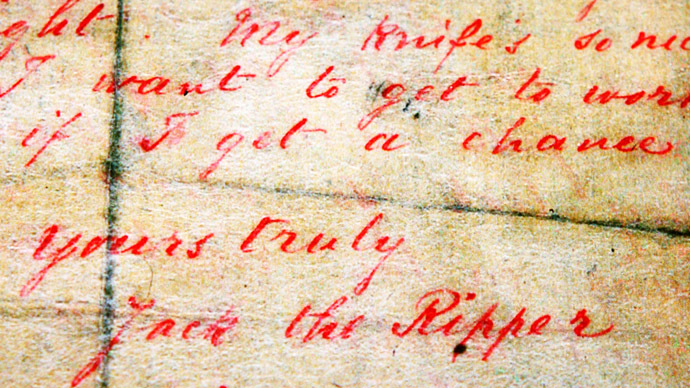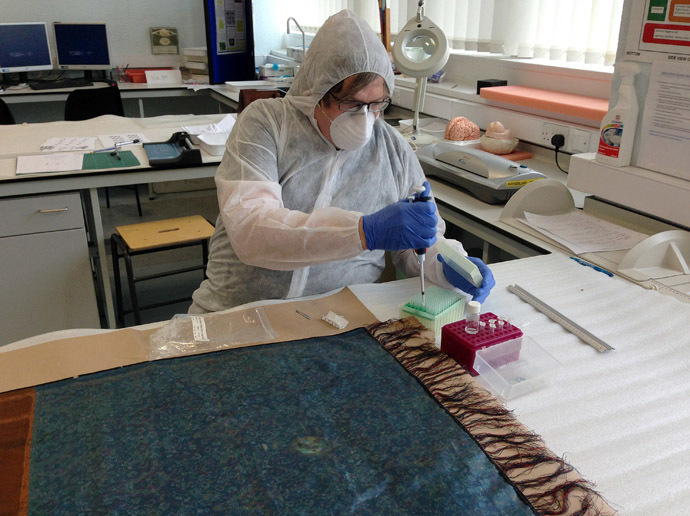DNA study ‘unmasks’ Jack the Ripper

19th century British serial killer Jack the Ripper has reportedly been identified using high-tech DNA technology called ‘vacuuming’. The DNA came from the shawl of one of his victim, according to a UK ‘armchair detective.’
48-year-old Russell Edwards stated that Aaron Kosminski, a 23-year-old Polish immigrant, was “definitely, categorically and absolutely” responsible for the chilling string of deaths in 1888 in London.
In 2007, Edwards purchased a blood-stained shawl reportedly belonging to one of the killer’s victims, Catherine Eddows, at an auction in Bury St Edmunds, Suffolk. The shawl was found next to the Eddows’ mutilated corpse, and was kept by a policeman as a gift for his wife. It is said, though, that the officer’s wife didn’t appreciate the blood-stained shawl and didn’t even try to clean it.
“I’ve got the only piece of forensic evidence in the whole history of the case,” Edwards said.
“I’ve spent 14 years working on it, and we have definitively solved the mystery of who Jack the Ripper was,” Edwards added, as cited by The Guardian.

In the book ‘Naming Jack the Ripper’ set to be published in Australia this week by Pan Macmillan, Edwards names Kosminski as the Ripper and describes the stunning technology that helped to nail him.
Edwards asked Jari Louhelainen, an expert in molecular biology, for help. Louhelainen used cutting-edge technology to discover traces of the woman’s DNA on the shawl – as well as the DNA of her possible killer.
The scientist extracted 126-year-old DNA samples from the material using a process called “vacuuming” and compared it with DNA from descendants of Eddowes and the suspect Kosminski, with both proving a perfect match. In Kosminski’s case, it was the DNA sample from a female descendant of his sister.

The process took about three and a half years.
“When we discovered the truth it was the most amazing feeling of my entire life,” Edwards said.
The ‘armchair detective’ from north London was initially “captivated” by Jack the Ripper’s mystery, and attempted to solve the case in his free time.
Other experts on Jack the Ripper doubt the findings, though.
Richard Cobb, who runs Jack the Ripper conventions and tours, told The Times that the blood-stained shawl had been touched by so many over more than a century that the DNA samples are now unreliable.

“The shawl has been openly handled by loads of people and been touched, breathed on, spat upon,” Cobb said.
Jack the Ripper brutally killed at least five women, cut their throats, removed some of their internal organs and left the mutilated bodies in alleyways in Whitechapel.
There were six main suspects in the case, including some from the highest echelons of English society at the time, like The Duke of Clarence. However, there is evidence that police viewed Kosminski as the chief suspect.
Eight years ago, the Metropolitan Police's Crime Museum received a copy of the memoir of a top officer, in which Chief Inspector Donald Swanson, who was the original officer in charge of the Ripper probe, had made handwritten notes.
The final words he wrote were: "Kosminski was the suspect."
Kosminski was a Polish Jewish immigrant who, escaping from persecution by Poland’s Russian rulers, came with his family to England in 1881 and lived in Mile End. He spent the last year of his life in a string of lunatic asylums, where he died in 1899 of gangrene.












